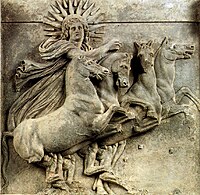User:Bigmoney/Sandbox17
Usilism
| Usilism Usilismo (Maroudian) | |
|---|---|
 A statue of Usil atop the Usileo Grand dule Naçonas, Farros | |
| Type | Ethnic religion |
| Classification | Mystery cult |
| Scripture | Classics |
| Theology | Henotheistic |
| Origin | Maroudia |
| Members | XMILLION |
| Other name(s) | Solarianism, Sol worship, Usil worship |
Usilism is a henotheistic religion centered on the worship of a solar deity typically known as Usil.
History
Usilism as a religion found its origins in the Kastorian Empire of late antiquity. Intially, what is today known as Usilism was merely one of many cults of deity worship common across the !Mediterranean world. The first recognizable forms of Usil worship come from the XCENTURY, when Kastorian legionnaries in modern-day eastern Maroudia began constructing secret usilea. This initial worship drew from disparate sources, namely a longstanding !Etruscan cult of worship to a solar god of the same name. Being Kastorian troops, these initial worshippers brought elements of worship from across the empire to this faith, namely Gionian conceptualizations of a solar deity and how to worship one. Nevertheless, crucial !Etruscan elements remained, such as the male and female facets of Usil and XYZ. The first usilea appear to have been secret affairs, though Usil worship at this time augmented, rather than conflicted with, the imperial cult of the time. The first century of Usil worship saw a limited spread across Kastorian lands; initial membership seems to have been restricted to an invitation basis, and the first members were solely imperial legionnaries. As Usil worship gained traction
As the Kastorian Empire entered its final decades, religious diversity increased rapidly and new religious movements competed to replace the cult of Dionysian worship and the near-singular grip it once had on public life. Usil worship saw its ranks similarly enlarge, with membership opened to men of high standing such as merchants, politicians and members of elite families. Usil worship reached wider segments of the Kastorian population, which began a second period of crackdown as more conservative emperors saw the threat of an Usil-worshipping empire as an existential threat. Unlike the first wave of persecution, the empire lacked the resources to suppress a more strengthened Usil worship. After a few short decades of half-hearted attempts at suppression, freedom of open worship for Usil devotees was secured by [SOME EDICT OR ANOTHER].
After the fall of the Kastorian Empire, numerous local leaders rushed to fill the power vacuum and claim legitimacy over former imperial provinces. In the decades following Kastorian withdrawal from Maroudia, the remnants of the !Etruscans were swiftly conquered by proto-Maroudian !Latin chieftains, ending their cultural independence and beginning their assimilation into Maroudian culture. In order to establish a sense of legitimacy, some Maroudian leaders adopted Kastorian stylings and titles to establish a sense of continuity. Among these, some went as far as to establish Usil worship as their main royal cult as a ready-made institution of state power. This official recognition, combined with the collapse of support for other deity cults at the same time, ushered in a period of dramatic transformation for the religion. Usilist temples began to...
Beliefs
The height of the Usilist religious calendar is December 25th, the traditional feast of Usil's birthday. Derived from the Kastorian calendar date of the winter solstice,
